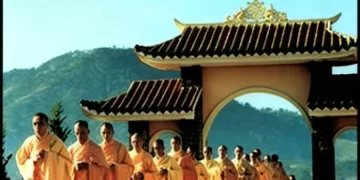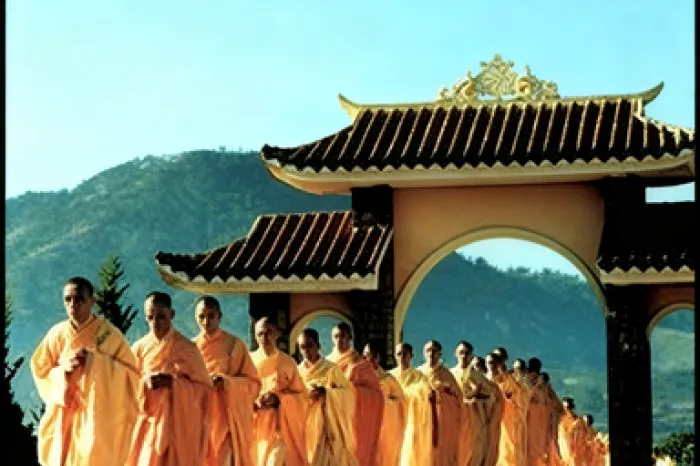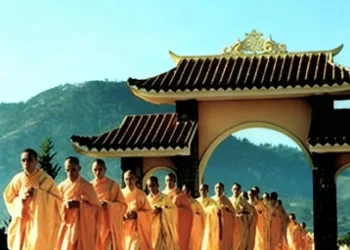The Bodhicitta Kickoff: A Reporter’s View from the Sidelines
Covering Mahayana Buddhism as an entertainment news reporter might sound like a curious assignment—there are no red carpets, no chart-topping singles, and no dramatic celebrity breakups. But what this tradition lacks in glitter, it more than makes up for in philosophical flair and an unexpectedly charming sense of spiritual showmanship. At the heart of Mahayana practice sits bodhicitta, the altruistic intention to pursue enlightenment for the benefit of others. It’s the kind of heroic selflessness Hollywood wishes it could bottle.
Think of bodhicitta as the ethical pre-game ritual: before anything else begins, practitioners warm up by reminding themselves that their meditation, chanting, or prostrations aren’t for personal glory. They are, quite literally, in it for all sentient beings. In a world where most motivations come wrapped in self-interest, this Mahayana kickoff feels refreshingly off-trend yet effortlessly profound. It sets the tone for everything that follows, shaping both method and mindset.
Supplication and Dedication: A Spiritual Three-Act Structure
After the bodhicitta opener, Mahayana practitioners move into what might be described as the “middle act” of the spiritual play: supplication. While it may not involve stage lights or dramatic monologues, it does feature heartfelt requests for guidance from Buddhas and Bodhisattvas—enlightened figures who represent the highest aspirations of wisdom and compassion. The gestures range from offering prayers to symbolic items meant to convey respect, gratitude, and humble intention.
For those accustomed to daily life’s transactional pace, this ritual invites a shift in rhythm. It’s not about asking for personal favors or cosmic shortcuts. Instead, it’s a conscious step toward aligning oneself with the compassionate ideals of the Mahayana tradition. And just when the audience thinks the curtain might fall, a final act appears: dedication. Here, practitioners offer any spiritual merit gained—not to boost their personal karmic score, but for the welfare of all beings everywhere. It’s the ultimate ensemble ending, the kind where every sentient character gets a share of the applause.
Meditation Across the Mahayana Map
If bodhicitta is the opening theme and dedication the emotional finish, meditation forms the ongoing narrative thread. In fact, meditation lies at the beating heart of Mahayana Buddhism. But this isn’t a one-size-fits-all practice; it’s more of a sprawling franchise with regional adaptations.
Take Chan—internationally known in its Japanese form, Zen. This school takes a refreshingly minimalist approach, emphasizing seated meditation (zazen) and direct experience over conceptual knowledge. It’s the no-frills, low-dialogue, highly contemplative indie film of Buddhism. Zen masters often speak in sharp, poetic phrases that leave students wondering whether they’ve just heard a profound truth or a cleverly timed punchline. And Seon in Korea or Thien in Vietnam follow the same spirit, each layering its own cultural nuance onto this shared meditative backbone.
Yet seated meditation isn’t the whole story. Across the Mahayana world, schools and lineages embrace practices ranging from chanting sutras to performing prostrations or joining elaborate ceremonies. These rituals aren’t just spectacles; they’re intentionally crafted to refine attention, deepen ethical awareness, and cultivate insight. A reporter watching these rituals unfold quickly learns that the Mahayana landscape is vast and varied—more like an interwoven anthology than a single storyline.
Sutras, Study, and the Bodhisattva Spotlight
No coverage of Mahayana practices would be complete without mentioning the Mahayana sutras, a series of scriptures that expand earlier Buddhist teachings with rich imagery and complex philosophical developments. They introduce characters who embody the Bodhisattva ideal—figures as inspiring as any real-world humanitarian, yet operating on a cosmic scale. Their mission isn’t personal liberation but universal uplift, making them the moral celebrities of the Mahayana universe.
Studying these sutras is more than an academic exercise; it’s a formative encounter with the values, metaphors, and bold ethical commitments that animate the tradition. In these texts, wisdom and compassion aren’t abstract ideals but dynamic forces that practitioners are called to cultivate. They articulate the virtues expected of those who walk the Bodhisattva path—generosity, patience, ethical clarity, meditative stability, and a kind of wisdom sharp enough to cut through delusion yet gentle enough to guide others.
A Patchwork of Lineages with Shared Purpose
Despite the diversity of schools and practices—from silent meditation halls to ceremonial chants—Mahayana Buddhism remains united by a shared aspiration: to pursue enlightenment not for oneself but for the benefit of all. Each lineage may lean into different forms, different teachers, or different ritual styles, but the overarching purpose stays steady.
For a journalist observing these traditions, the most striking feature isn’t the ritual variety but the continuity of intent. Whether practitioners sit in stillness, recite sutras, or bow in rhythmic sequences, they do so with an orientation that pushes beyond individual gain. They’re participating in a centuries-old movement defined by compassion, resilience, and a genuine commitment to collective wellbeing.
A Modern Interpretation with Ancient Bones
What makes Mahayana practices particularly compelling in a contemporary setting is their ability to balance depth with accessibility. They offer room for introspection without demanding isolation, emphasizing community and ethical engagement as essential components of spiritual life. This gives the tradition a resonance that extends far beyond monastic walls. Its practices are both ancient and surprisingly adaptable, offering tools for navigating the anxieties and complexities of modern living.
In an entertainment landscape saturated with quick fixes and fleeting trends, Mahayana Buddhism stands out with its slow-burn, purpose-driven approach. Its practices encourage people to pause, breathe, and consider the welfare of others—a narrative direction that feels refreshingly grounded.
The Takeaway: A Practice Rooted in Compassion
To sum it up, the practices of Mahayana Buddhism unfold like a layered story—one shaped by intention, ritual, meditation, study, and a steadfast commitment to the Bodhisattva ideal. The humor lies in its simplicity; the depth lies in its execution. As a reporter covering the human side of spiritual traditions, one can’t help but note that Mahayana Buddhism’s most enduring practice may simply be its unwavering belief in collective uplift.
And in a world constantly searching for the next big thing, that might just be the quiet revolution worth paying attention to.



























